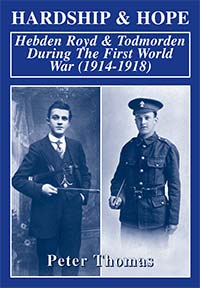Hardship and Hope - Hebden Royd and Todmorden during WW1
Sunday, 10 July 2016
 The chance discovery of a fascinating inscription in an old Lord Wharton Bible in 2013 aroused the interest of local author, Peter Thomas. The inscription on the fly leaf dated from late 1918 and consisted of a tribute from a James Thomas to his younger brother, Robert Arnold Thomas who, aged 21, had died of wounds in a Manchester hospital on November 16th 1918, from injuries sustained near Albert on August 5th 1918. Peter wanted to find out more about these brothers who shared his surname.
The chance discovery of a fascinating inscription in an old Lord Wharton Bible in 2013 aroused the interest of local author, Peter Thomas. The inscription on the fly leaf dated from late 1918 and consisted of a tribute from a James Thomas to his younger brother, Robert Arnold Thomas who, aged 21, had died of wounds in a Manchester hospital on November 16th 1918, from injuries sustained near Albert on August 5th 1918. Peter wanted to find out more about these brothers who shared his surname.
His researches uncovered the facts that they lived at 24 Oak Street, Hebden Bridge; were involved in the clothing trade; and seemingly were unrelated to the author's family. From such small beginnings the scope of his research widened, the ultimate result being the recent publication of a book, Hardship and Hope – Hebden Royd and Todmorden during the First World War (1914-1918).
"It seemed to me," states Peter, "that the tragedy which struck the family of Robert Thomas was one which found an echo in many families in the Upper Calder Valley. How did they cope with their losses? How did they cope with the other demands that total war imposed upon them?
One demand above all provides a major theme running through this book – the apparently insatiable need of the British army for more and more men. The great recruiting campaigns gave way to conscription, but nothing posed more of a threat to social unity than the suspicion that local Military Tribunals were guilty of favouritism in the granting of exemptions from conscription. Other themes that provided a backcloth to the great conflict were the shortages of food and other consumer goods; rocketing prices; fear of zeppelin attacks; the imposition of blackouts and last, but not least, the passing of D.O.R.A. (the Defence of the Realm Act) which gave the government huge powers to interfere in all walks of life in the name of national security.

Not that it was all a negative picture. Wars can bring benefits. Hebden Bridge and Mytholmroyd, for example, enjoyed lucrative contracts for the production of khaki uniforms which kept the mills humming. Women in general could enhance their status (and incomes) by taking over jobs that had previously been dominated by men who were now in uniform. Nevertheless it was the ever lengthening casualty lists which dominated the lives of those living on the hilltops and along the valley from Luddenden Foot to Todmorden. If the press was censored, then the letters home from servicemen were not in terms of describing the terrible conditions under which they laboured at the fighting fronts. Hardship and Hope is peppered with snippets from such letters which brought home the grim reality of war, and one of the grimmest ordeals was the struggle at Gallipoli in 1915. A full chapter is devoted to this because of its great resonance with the people of Todmorden.
In the end, despite all the strains which threatened to fracture social unity, at a local and national level one binding influence preserved this unity. This was, as the author says, "the conviction that this was a just war against unbridled German militarism."
Informative and interesting, Hardship and Hope is available from local bookshops, tourist information centres and other retail outlets (price £13) or at direct from the author, post free in the UK.


